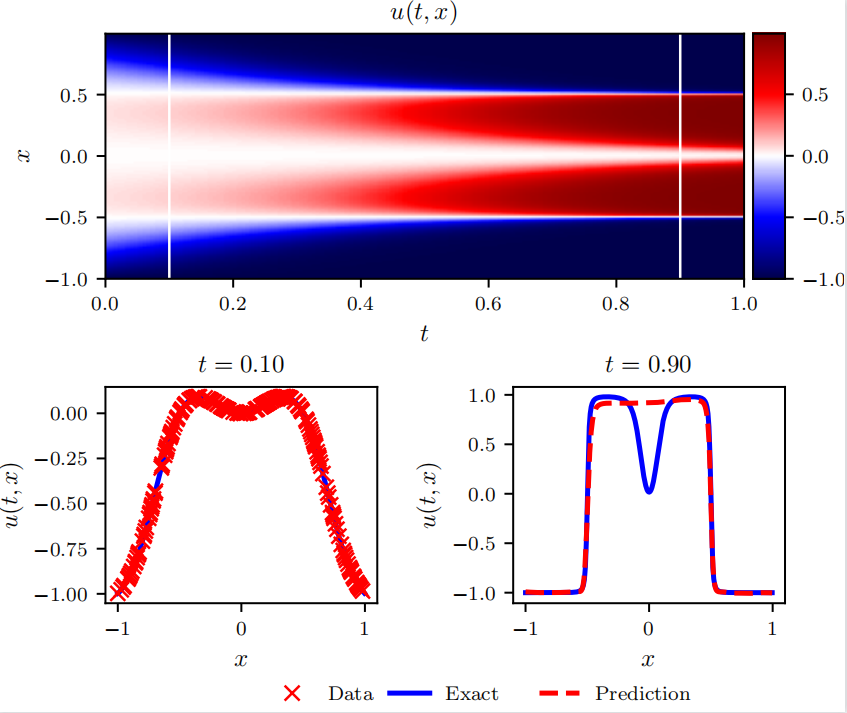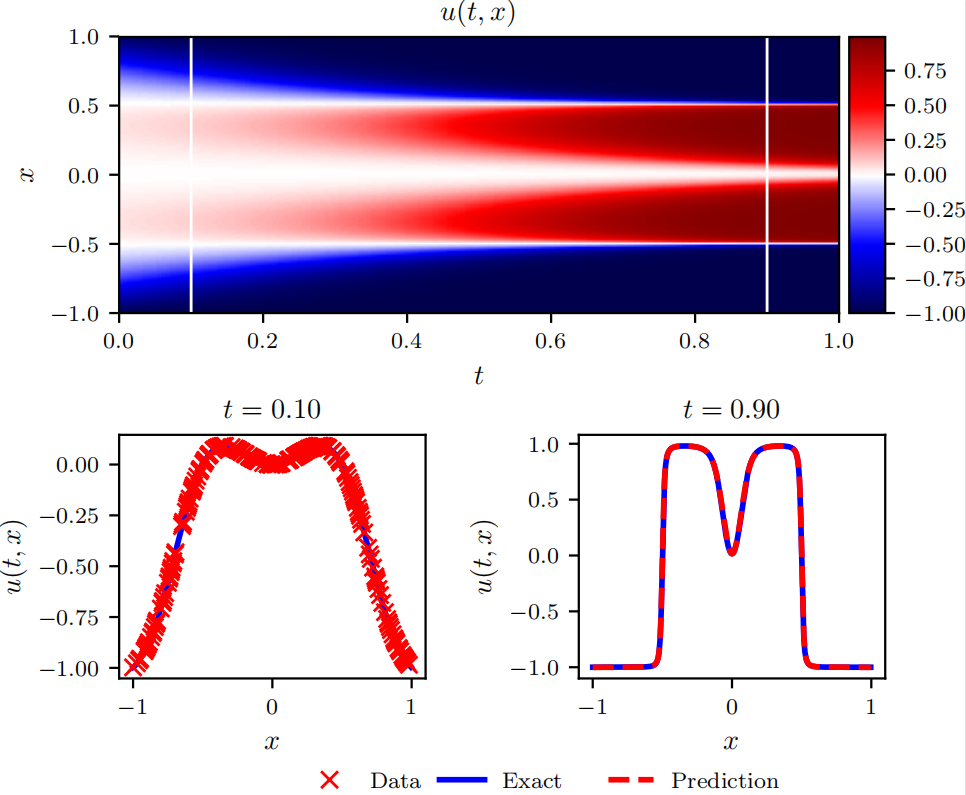PINN解偏微分方程实例3之Allen-Cahn方程
1. Allen-Cahn方程
考虑偏微分方程如下:
u t − 0.0001 u x x + 5 u 3 − 5 u = 0 u ( 0 , x ) = x 2 c o s ( π x ) u ( t , − 1 ) = u ( t , 1 ) u x ( t , − 1 ) = u x ( t , 1 ) \begin{align} \begin{aligned} & u_t - 0.0001u_{xx} + 5u^3 -5u = 0 \\ & u(0,x) = x^2cos(\pi x) \\ & u(t,-1) = u(t,1) \\ & u_x(t,-1) = u_x(t,1) \end{aligned} \end{align} ut−0.0001uxx+5u3−5u=0u(0,x)=x2cos(πx)u(t,−1)=u(t,1)ux(t,−1)=ux(t,1)
其中 x ∈ [ − 1 , 1 ] , t ∈ [ 0 , 1 ] . x\in[-1,1],t\in[0,1]. x∈[−1,1],t∈[0,1].这是一个带有周期性边界条件,初始条件的偏微分方程。这个方程主要用 P I N N [ 1 ] PINN^{[1]} PINN[1]论文中正向问题的离散时间模型求解。
2. 损失函数如下定义
S S E = S S E n + S S E b \begin{align} \begin{aligned} SSE = SSE_n + SSE_b \\ \end{aligned} \end{align} SSE=SSEn+SSEb
其中
S S E n = ∑ j = 1 q + 1 ∑ i = 1 N n ∣ u j n ( x n , i ) − u n , i ∣ 2 S S E b = ∑ i = 1 q ∣ u n + c i ( − 1 ) − u n + c i ( 1 ) ∣ 2 + ∣ u n + 1 ( − 1 ) − u n + 1 ( 1 ) ∣ 2 + ∑ i = 1 q ∣ u x n + c i ( − 1 ) − u x n + c i ( 1 ) ∣ 2 + ∣ u x n + 1 ( − 1 ) − u x n + 1 ( 1 ) ∣ 2 \begin{align} \begin{aligned} SSE_n &= \sum_{j=1}^{q+1}\sum_{i=1}^{N_n}|u_j^{n}(x^{n,i})-u^{n,i}|^2 \\ SSE_b &= \sum_{i=1}^{q} |u^{n+c_i}(-1)-u^{n+c_i}(1)|^2+ |u^{n+1}(-1)-u^{n+1}(1)|^2 \\ &+\sum_{i=1}^{q} |u_x^{n+c_i}(-1)-u_x^{n+c_i}(1)|^2+ |u_x^{n+1}(-1)-u_x^{n+1}(1)|^2 \\ \end{aligned} \end{align} SSEnSSEb=j=1∑q+1i=1∑Nn∣ujn(xn,i)−un,i∣2=i=1∑q∣un+ci(−1)−un+ci(1)∣2+∣un+1(−1)−un+1(1)∣2+i=1∑q∣uxn+ci(−1)−uxn+ci(1)∣2+∣uxn+1(−1)−uxn+1(1)∣2
这里 S S E b SSE_b SSEb是周期性边界损失, S S E n SSE_n SSEn可以理解为PDE损失, { x n , i , u n , i } ∣ i = 1 N n \{x^{n,i},u^{n,i}\}|_{i=1}^{N_n} {
xn,i,un,i}∣i=1Nn为 t n t^n tn时刻相应的数据点和真解。 u j n ( x n , i ) u_j^{n}(x^{n,i}) ujn(xn,i)利用公式(4)、(5)计算得到。
u n + c i = u n − Δ t ∑ j = 1 q a i j N [ u n + c j ] , i = 1 , 2 , . . . , q u n + 1 = u n − Δ t ∑ j = 1 q b j N [ u n + c j ] . \begin{align} \begin{aligned} u^{n+c_i} &= u^n - \Delta t \sum_{j=1}^q a_{ij} \mathcal{N}[u^{n+c_j}], \quad i=1,2,...,q \\ u^{n+1} &= u^n - \Delta t \sum_{j=1}^q b_{j} \mathcal{N}[u^{n+c_j}]. \end{aligned} \end{align} un+ciun+1=un−Δtj=1∑qaijN[un+cj],i=1,2,...,q=un−Δtj=1∑qbjN[un+cj].
公式(4)中 N [ u n + c j ] \mathcal{N}[u^{n+c_j}] N[un+cj]表达式如公式(5)所示。
N [ u n + c j ] = − 0.0001 u x x n + c j + 5 ( u n + c j ) 3 − 5 u n + c j \begin{align} \begin{aligned} \mathcal{N}[u^{n+c_j}] = -0.0001u_{xx}^{n+c_j} + 5(u^{n+c_j})^3 - 5u^{n+c_j} \end{aligned} \end{align} N[un+cj]=−0.0001uxxn+cj+5(un+cj)3−5un+cj
这里 N n = 200 , q = 100 , Δ t = 0.8 N_n=200,q=100,\Delta t=0.8 Nn=200,q=100,Δt=0.8。神经网络模型输入层包括一个神经元,四个100神经元的隐藏层,101个神经元的输出层。
3. 代码
代码参考下图进行理解。

代码参考https://github.com/maziarraissi/PINNs,原代码运行框架tensorflow1,这里将其改为tensorflow2上运行,代码如下:
"""
@author: Maziar Raissi
@Annotator:ST
计算t*x为[0,1]*[-1,1]区域上的真解,真解个数t*x为201*256
"""
import sys
sys.path.insert(0, '../../Utilities/')
import tensorflow.compat.v1 as tf # tensorflow1.0代码迁移到2.0上运行,加上这两行
tf.disable_v2_behavior()
# import tensorflow as tf
import numpy as np
import matplotlib.pyplot as plt
import time
import scipy.io
from plotting import newfig, savefig
import matplotlib.gridspec as gridspec
from mpl_toolkits.axes_grid1 import make_axes_locatable
np.random.seed(1234)
tf.set_random_seed(1234)
class PhysicsInformedNN:
# Initialize the class
def __init__(self, x0, u0, x1, layers, dt, lb, ub, q):
"""
input: 200个t=0.1时x坐标,x=-1,1 输入202个样本
output: 每个坐标输出这个坐标在未来q个时间的解和t+dt时刻的解,输出维度分别为(200*101)(2*101)
:param x0: 空间选定的200个点的x坐标值
:param u0: 200个x在t=0.1时对应的u的精确解
:param x1: 空间边界[[-1],[1]]
:param layers: 神经网络各层神经元列表
:param dt: 时间步长 0.8
:param lb: -1
:param ub: 1
:param q: q阶龙格库达,即t方向取q个点的斜率的加权平均作为龙格库达法的平均斜率
"""
self.lb = lb
self.ub = ub
self.x0 = x0
self.x1 = x1
self.u0 = u0
self.layers = layers
self.dt = dt
self.q = max(q,1)
# Initialize NN
self.weights, self.biases = self.initialize_NN(layers)
# Load IRK weights
tmp = np.float32(np.loadtxt('../../Utilities/IRK_weights/Butcher_IRK%d.txt' % (q), ndmin = 2))
self.IRK_weights = np.reshape(tmp[0:q**2+q], (q+1,q))
self.IRK_times = tmp[q**2+q:]
# tf placeholders and graph
self.sess = tf.Session(config=tf.ConfigProto(allow_soft_placement=True,
log_device_placement=True))
self.x0_tf = tf.placeholder(tf.float32, shape=(None, self.x0.shape[1]))
self.x1_tf = tf.placeholder(tf.float32, shape=(None, self.x1.shape[1]))
self.u0_tf = tf.placeholder(tf.float32, shape=(None, self.u0.shape[1]))
self.dummy_x0_tf = tf.placeholder(tf.float32, shape=(None, self.q)) # dummy variable for fwd_gradients
self.dummy_x1_tf = tf.placeholder(tf.float32, shape=(None, self.q+1)) # dummy variable for fwd_gradients
self.U0_pred = self.net_U0(self.x0_tf) # N(200) x (q+1) 200个x内部点输入网络训练
self.U1_pred, self.U1_x_pred= self.net_U1(self.x1_tf) # N1(=2) x (q+1) x=-1,1 输入网络得到边界
# self.U1_pred (2*101) 分别对应x=-1,1时的预测的dt内q个真解和一个u^{n+1}时的真解
self.loss = tf.reduce_sum(tf.square(self.u0_tf - self.U0_pred)) + \
tf.reduce_sum(tf.square(self.U1_pred[0,:] - self.U1_pred[1,:])) + \
tf.reduce_sum(tf.square(self.U1_x_pred[0,:] - self.U1_x_pred[1,:]))
# self.optimizer = tf.contrib.opt.ScipyOptimizerInterface(self.loss,
# method = 'L-BFGS-B',
# options = {'maxiter': 50000,
# 'maxfun': 50000,
# 'maxcor': 50,
# 'maxls': 50,
# 'ftol' : 1.0 * np.finfo(float).eps})
self.optimizer_Adam = tf.train.AdamOptimizer()
self.train_op_Adam = self.optimizer_Adam.minimize(self.loss)
init = tf.global_variables_initializer()
self.sess.run(init)
def initialize_NN(self, layers):
weights = []
biases = []
num_layers = len(layers)
for l in range(0,num_layers-1):
W = self.xavier_init(size=[layers[l], layers[l+1]])
b = tf.Variable(tf.zeros([1,layers[l+1]], dtype=tf.float32), dtype=tf.float32)
weights.append(W)
biases.append(b)
return weights, biases
def xavier_init(self, size):
in_dim = size[0]
out_dim = size[1]
xavier_stddev = np.sqrt(2/(in_dim + out_dim))
return tf.Variable(tf.truncated_normal([in_dim, out_dim], stddev=xavier_stddev), dtype=tf.float32)
def neural_net(self, X, weights, biases):
num_layers = len(weights) + 1
H = 2.0*(X - self.lb)/(self.ub - self.lb) - 1.0
for l in range(0,num_layers-2):
W = weights[l]
b = biases[l]
H = tf.tanh(tf.add(tf.matmul(H, W), b))
W = weights[-1]
b = biases[-1]
Y = tf.add(tf.matmul(H, W), b)
return Y
def fwd_gradients_0(self, U, x):
g = tf.gradients(U, x, grad_ys=self.dummy_x0_tf)[0]
return tf.gradients(g, self.dummy_x0_tf)[0]
def fwd_gradients_1(self, U, x):
g = tf.gradients(U, x, grad_ys=self.dummy_x1_tf)[0]
return tf.gradients(g, self.dummy_x1_tf)[0]
def net_U0(self, x):
U1 = self.neural_net(x, self.weights, self.biases)
U = U1[:,:-1]
U_x = self.fwd_gradients_0(U, x)
U_xx = self.fwd_gradients_0(U_x, x)
F = 5.0*U - 5.0*U**3 + 0.0001*U_xx
U0 = U1 - self.dt*tf.matmul(F, self.IRK_weights.T) # IRK_weights(101*100) 包括了Runde-Kutta方法参数a,b
return U0
def net_U1(self, x):
U1 = self.neural_net(x, self.weights, self.biases)
U1_x = self.fwd_gradients_1(U1, x)
return U1, U1_x # N x (q+1)
def callback(self, loss):
print('Loss:', loss)
def train(self, nIter):
tf_dict = {
self.x0_tf: self.x0, self.u0_tf: self.u0, self.x1_tf: self.x1,
self.dummy_x0_tf: np.ones((self.x0.shape[0], self.q)),
self.dummy_x1_tf: np.ones((self.x1.shape[0], self.q+1))}
start_time = time.time()
for it in range(nIter):
self.sess.run(self.train_op_Adam, tf_dict)
# Print
if it % 10 == 0:
elapsed = time.time() - start_time
loss_value = self.sess.run(self.loss, tf_dict)
print('It: %d, Loss: %.3e, Time: %.2f' %
(it, loss_value, elapsed))
start_time = time.time()
# self.optimizer.minimize(self.sess,
# feed_dict = tf_dict,
# fetches = [self.loss],
# loss_callback = self.callback)
def predict(self, x_star):
U1_star = self.sess.run(self.U1_pred, {
self.x1_tf: x_star})
return U1_star
if __name__ == "__main__":
q = 100
layers = [1, 200, 200, 200, 200, q+1]
lb = np.array([-1.0])
ub = np.array([1.0])
N = 200
data = scipy.io.loadmat('../Data/AC.mat')
t = data['tt'].flatten()[:,None] # T(201) x 1 精确解时间坐标节点
x = data['x'].flatten()[:,None] # N(512) x 1 精确解空间坐标节点
Exact = np.real(data['uu']).T # T x N 精确解
idx_t0 = 20
idx_t1 = 180
dt = t[idx_t1] - t[idx_t0] # 时间步长0.8
# Initial data
noise_u0 = 0.0
idx_x = np.random.choice(Exact.shape[1], N, replace=False) # 随机选择空间200个点的下标索引
x0 = x[idx_x,:] # 空间200个点的x坐标值
u0 = Exact[idx_t0:idx_t0+1,idx_x].T # t=0.10时200个精确解
u0 = u0 + noise_u0*np.std(u0)*np.random.randn(u0.shape[0], u0.shape[1])
# Boudanry data
x1 = np.vstack((lb,ub))
# Test data
x_star = x
model = PhysicsInformedNN(x0, u0, x1, layers, dt, lb, ub, q)
model.train(2) # 10000
U1_pred = model.predict(x_star) # (512,101)
error = np.linalg.norm(U1_pred[:,-1] - Exact[idx_t1,:], 2)/np.linalg.norm(Exact[idx_t1,:], 2)
print('Error: %e' % (error)) # sqrt(sum_{i=1}^512 (u-u_{ext})) / sqrt(sum_{i=1}^512 (u_{ext})) 相对误差
######################################################################
############################# Plotting ###############################
######################################################################
fig, ax = newfig(1.0, 1.2)
ax.axis('off')
####### Row 0: h(t,x) ##################
gs0 = gridspec.GridSpec(1, 2)
gs0.update(top=1-0.06, bottom=1-1/2 + 0.1, left=0.15, right=0.85, wspace=0)
ax = plt.subplot(gs0[:, :])
h = ax.imshow(Exact.T, interpolation='nearest', cmap='seismic',
extent=[t.min(), t.max(), x_star.min(), x_star.max()],
origin='lower', aspect='auto')
divider = make_axes_locatable(ax)
cax = divider.append_axes("right", size="5%", pad=0.05)
fig.colorbar(h, cax=cax)
line = np.linspace(x.min(), x.max(), 2)[:,None]
ax.plot(t[idx_t0]*np.ones((2,1)), line, 'w-', linewidth = 1)
ax.plot(t[idx_t1]*np.ones((2,1)), line, 'w-', linewidth = 1)
ax.set_xlabel('$t$')
ax.set_ylabel('$x$')
leg = ax.legend(frameon=False, loc = 'best')
ax.set_title('$u(t,x)$', fontsize = 10)
####### Row 1: h(t,x) slices ##################
gs1 = gridspec.GridSpec(1, 2)
gs1.update(top=1-1/2-0.05, bottom=0.15, left=0.15, right=0.85, wspace=0.5)
ax = plt.subplot(gs1[0, 0])
ax.plot(x,Exact[idx_t0,:], 'b-', linewidth = 2)
ax.plot(x0, u0, 'rx', linewidth = 2, label = 'Data')
ax.set_xlabel('$x$')
ax.set_ylabel('$u(t,x)$')
ax.set_title('$t = %.2f$' % (t[idx_t0]), fontsize = 10)
ax.set_xlim([lb-0.1, ub+0.1])
ax.legend(loc='upper center', bbox_to_anchor=(0.8, -0.3), ncol=2, frameon=False)
ax = plt.subplot(gs1[0, 1])
ax.plot(x,Exact[idx_t1,:], 'b-', linewidth = 2, label = 'Exact')
ax.plot(x_star, U1_pred[:,-1], 'r--', linewidth = 2, label = 'Prediction')
ax.set_xlabel('$x$')
ax.set_ylabel('$u(t,x)$')
ax.set_title('$t = %.2f$' % (t[idx_t1]), fontsize = 10)
ax.set_xlim([lb-0.1, ub+0.1])
ax.legend(loc='upper center', bbox_to_anchor=(0.1, -0.3), ncol=2, frameon=False)
savefig('./figures/retest/reAC')
4. 实验细节及复现结果
这里使用4层全连接神经网络,输入层和输出层各两个神经元,输入层一个神经元代表 x x x坐标值,输出层101个神经元分别代表 [ u n + c 1 ( x ) , ⋯ , u n + c q ( x ) , u n + 1 ( x ) ] [u^{n+c_1}(x),\cdots,u^{n+c_q}(x),u^{n+1}(x)] [un+c1(x),⋯,un+cq(x),un+1(x)],隐藏层每层100个神经元。为了计算误差,作者提供了使用谱方法计算的 ( 256 ∗ 201 ) (256*201) (256∗201)个真解,其中第一维度代表空间 x x x,第二维度代表时间 t t t. 训练10000次之后输出结果如下:
It: 9970, Loss: 5.127e+00, Time: 0.08
It: 9980, Loss: 1.335e+01, Time: 0.07
It: 9990, Loss: 2.095e+01, Time: 0.07
Error: 2.470155e-01
这里误差是相对误差,计算公式如下:
E r r o r = ∣ ∣ U − U e x t ∣ ∣ 2 ∣ ∣ U e x t ∣ ∣ 2 \begin{align} \begin{aligned} Error = \frac{||U-U_{ext}||_2}{||U_{ext}||_2} \end{aligned} \end{align} Error=∣∣Uext∣∣2∣∣U−Uext∣∣2
其中 U ∈ R 512 × 1 , U e x t ∈ R 512 × 1 U \in \mathbb{R}^{512 \times 1},U_{ext}\in \mathbb{R}^{512 \times 1} U∈R512×1,Uext∈R512×1,前者为 t = 0.9 t=0.9 t=0.9时PINN预测的解,后者为 t = 0.9 t=0.9 t=0.9时计算的精确解。复现结果图如下:

论文中结果如下:
